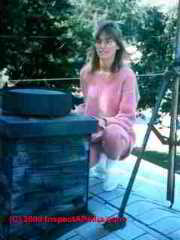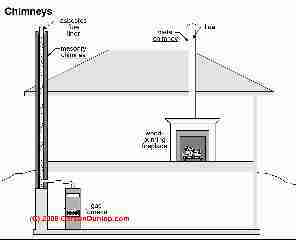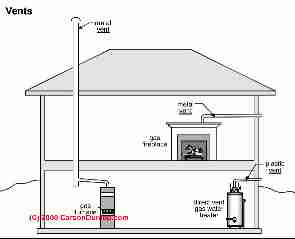 Chimney Definitions
Chimney Definitions
manufactured, chimney, flue, vent,
vent-connector
- POST a QUESTION or COMMENT about the different types of manufactured or metal chimneys, flues, flue vent connectors and other fireplace or heating appliance venting systems
This article defines the types of manufactured metal chimneys.
We explain the difference between Class-A Chimneys, Metalbestos chimneys, Type B Vents, Type L Vents, Triple Wall metal chimneys, and Super Chimneys, 629 Chimneys, and 650-C Chimneys. Each of these chimney types has specific intended uses, fire clearances, and installation requirements.
InspectAPedia tolerates no conflicts of interest. We have no relationship with advertisers, products, or services discussed at this website.
- Daniel Friedman, Publisher/Editor/Author - See WHO ARE WE?
Define Chimney, Vent, Flue Vent Connector, Flue Pipe, Smoke Pipe
 We give definitions of these terms just below, but beware: different people will use these words with different meanings.
We give definitions of these terms just below, but beware: different people will use these words with different meanings.
Also see CHIMNEY TYPES & MATERIALS.
Definition of Chimney: a chimney is a passage through which smoke and combustion gases pass out of a building.
[Click to enlarge any image]
A chimney may be made of masonry such as brick, stone, or concrete block. Depending on its age and local custom, the walls of a chimney may be thin - a single brick in thickness or thicker (safer) made of several bricks or made of masonry block or stone.
A chimney may also be lined with clay flue tile liners, asbestos-cement transite pipe, cement, metal, or flexible stainless steel.
A chimney may also be constructed of metal, such as a double-walled Metalbestos™ insulated chimney.
A masonry chimney (lined with transite pipe) and a metal chimney are shown here in Carson Dunlop Associates [at REVIEWERS] sketches.
Define Flue: a flue is in most cases a synonym for chimney.
 Definition of Vent or chimney vent or flu vent: A metal chimney which is "thin walled" - either a single wall of metal or a thin double wall in some areas is called a "vent".
Definition of Vent or chimney vent or flu vent: A metal chimney which is "thin walled" - either a single wall of metal or a thin double wall in some areas is called a "vent".
A double-walled metal flue used for venting gas fired appliances in the U.S. and Canada is a Type-B vent. In some areas a single-walled vent might be used for gas-fired equipment such as a water heater.
A single-walled metal vent or a Type-B vent would be unsafe if used to vent a woodstove or oil-fired equipment.
A metal vent is shown here in Carson Dunlop Associates [at REVIEWERS] sketch.
Definition of Flue Vent Connector: a flue vent connector is a metal pipe used to connect a heating appliance such as a heating boiler or water heater to its chimney or vent.
Definition of Flue pipe and stack pipe - these are usually synonyms for flue vent connector. Generally a flue-vent connector is single-walled steel and must be routed with proper clearance from combustible materials.
See FLUE VENT CONNECTORS, HEATING EQUIPMENT for details about single wall metal flues and their fire clearance requirements.
What are the Different Types of Metal Chimneys and Metal Vents?
Definition of Manufactured Chimneys
Manufactured chimneys of multiple metal walls or plastic have less weight than masonry chimneys and can be supported from the structure since they can deflect as the building moves with no problem. Readers should also see our more broad list of chimney types
Some segmented cementitious manufactured chimneys can be supported with a steel bracket bolted to reinforced joists to carry the weight.
Often manufactured chimneys are enclosed in a wood-framed and sided structure for cosmetic reasons.
List of Manufactured Metal Chimney Types
Here are the principal types of manufactured metal chimneys. We discuss each of these in the articles below.
- CLASS A CHIMNEYS, MetalBestos™
- TYPE B-VENT CHIMNEYS
- TYPE L VENT CHIMNEYS
- TRIPLE-WALL METAL FIREPLACE CHIMNEYS
- SUPER CHIMNEYS, 629 CHIMNEYS
- FIRE CLEARANCES, FLUE VENT CONNECTORS are not chimneys but rather single-wall metal pipes used to connect a heating appliance to a chimney.
...
Reader Comments, Questions & Answers About The Article Above
Below you will find questions and answers previously posted on this page at its page bottom reader comment box.
Reader Q&A - also see RECOMMENDED ARTICLES & FAQs
Question: Tree trimmer observes chimney damage
(Jan 15, 2013) Frank Zook said:
Your site is fantastic .I am a tree trimmer by trade. while I was above the house I had noticed the chimney needed to be repaired. I have some experience laying bricks and tuck pointing.long story short the chimney needs to be completely rebuilt ,from top to bottom . would a cost effective solution be to use,type-B vents. and do away with the exposed brick and mortar. Roof over the old chimney.
...
Continue reading at CHIMNEY TYPES & MATERIALS or select a topic from the closely-related articles below, or see the complete ARTICLE INDEX.
Or see
CHIMNEY INSPECTION DIAGNOSIS REPAIR
Suggested citation for this web page
CHIMNEY DEFINITIONS at InspectApedia.com - online encyclopedia of building & environmental inspection, testing, diagnosis, repair, & problem prevention advice.
Or see this
INDEX to RELATED ARTICLES: ARTICLE INDEX to CHIMNEYS & FLUES
Or use the SEARCH BOX found below to Ask a Question or Search InspectApedia
Ask a Question or Search InspectApedia
Try the search box just below, or if you prefer, post a question or comment in the Comments box below and we will respond promptly.
Search the InspectApedia website
Note: appearance of your Comment below may be delayed: if your comment contains an image, photograph, web link, or text that looks to the software as if it might be a web link, your posting will appear after it has been approved by a moderator. Apologies for the delay.
Only one image can be added per comment but you can post as many comments, and therefore images, as you like.
You will not receive a notification when a response to your question has been posted.
Please bookmark this page to make it easy for you to check back for our response.
IF above you see "Comment Form is loading comments..." then COMMENT BOX - countable.ca / bawkbox.com IS NOT WORKING.
In any case you are welcome to send an email directly to us at InspectApedia.com at editor@inspectApedia.com
We'll reply to you directly. Please help us help you by noting, in your email, the URL of the InspectApedia page where you wanted to comment.
Citations & References
In addition to any citations in the article above, a full list is available on request.
- Mark Cramer Inspection Services Mark Cramer, Tampa Florida, Mr. Cramer is a past president of ASHI, the American Society of Home Inspectors and is a Florida home inspector and home inspection educator. Mr. Cramer serves on the ASHI Home Inspection Standards. Contact Mark Cramer at: 727-595-4211 mark@BestTampaInspector.com
- John Cranor [Website: /www.house-whisperer.com ] is an ASHI member and a home inspector (The House Whisperer) is located in Glen Allen, VA 23060. He is also a contributor to InspectApedia.com in several technical areas such as plumbing and appliances (dryer vents). Contact Mr. Cranor at 804-873-8534 or by Email: johncranor@verizon.net
- Thanks to Luke Barnes for suggesting that we add text regarding the hazards of shared chimney flues. USMA - Sept. 2008.
- Fire Inspector Guidebook, A Correlation of Fire Safety Requirements Contained in the 1987 BOCA National Codes, (newer edition available), Building Officials and Code Administrators International, Inc. (BOCA), Country Club HIlls, IL 60478 312-799-2300 4th ed. Note: this document is reissued every four years. Be sure to obtain the latest edition.
- Uniform Mechanical Code - UMC 1991, Sec 913 (a.) Masonry Chimneys, refers to Chapters 23, 29, and 37 of the Building Code.
- New York 1984 Uniform Fire Prevention and Building Code, Article 10, Heating, Ventilating, and Air Conditioning Requirements
- New York 1979 Uniform Fire Prevention & Building Code, The "requirement" for 8" of solid masonry OR for use of a flue liner was listed in the One and Two Family Dwelling Code for New York, in 1979, in Chapter 9, Chimneys and Fireplaces, New York 1979 Building and Fire Prevention Code:
- "Top Ten Chimney (and related) Problems Encountered by One Chimney Sweep," Hudson Valley ASHI education seminar, 3 January 2000, contributed by Bob Hansen, ASHI
- Chimney Inspection Checklist, Carson Dunlop, Associates, Toronto, Ontario
- "Rooftop View Turns to Darkness," Martine Costello, Josh Kovner, New Haven Register, 12 May 1992 p. 11: Catherine Murphy was sunning on a building roof when a chimney collapsed; she fell into and was trapped inside the chimney until rescued by emergency workers.
- "Chimneys and Vents," Mark J. Reinmiller, P.E., ASHI Technical Journal, Vol. 1 No. 2 July 1991 p. 34-38.
- "Chimney Inspection Procedures & Codes," Donald V. Cohen was to be published in the first volume of the 1994 ASHI Technical Journal by D. Friedman, then editor/publisher of that publication. The production of the ASHI Technical Journal and future editions was cancelled by ASHI President Patrick Porzio. Some of the content of Mr. Cohen's original submission has been included in this more complete chimney inspection article: CHIMNEY INSPECTION DIAGNOSIS REPAIR . Copies of earlier editions of the ASHI Technical Journal are available from ASHI, the American Society of Home Inspectors.
- Natural Gas Weekly Update: http://tonto.eia.doe.gov/oog/info/ngw/ngupdate.asp Official Energy Statistics from the U.S. Government
- US Energy Administration: Electrical Energy Costs http://www.eia.doe.gov/fuelelectric.html
- Our recommended books about building & mechanical systems design, inspection, problem diagnosis, and repair, and about indoor environment and IAQ testing, diagnosis, and cleanup are at the InspectAPedia Bookstore. Also see our Book Reviews - InspectAPedia.
- Chimney & Stack Inspection Guidelines, American Society of Civil Engineers, 2003 - These guidelines address the inspection of chimneys and stacks. Each guideline assists owners in determining what level of inspection is appropriate to a particular chimney and provides common criteria so that all parties involved have a clear understanding of the scope of the inspection and the end product required. Each chimney or stack is a unique structure, subject to both aggressive operating and natural environments, and degradation over time. Such degradation may be managed via a prudent inspection program followed by maintenance work on any equipment or structure determined to be in need of attention. Sample inspection report specifications, sample field inspection data forms, and an example of a developed plan of a concrete chimney are included in the guidelines. This book provides a valuable guidance tool for chimney and stack inspections and also offers a set of references for these particular inspections.
- NFPA 211 - 3-1.10 - Relining guide for chimneys
- NFPA 211 - 3-2 - Construction of Masonry Chimneys
- NFPA 211 - 3-3 - Termination Height for chimneys
- NFPA 211 - 3-4 - Clearance from Combustible Material
- NFPA 54 - 7-1 - Venting of Equipment into chimneys
- Brick Institute of America - Flashing Chimneys
Brick Institute of America - Proper Chimney Crowns
Brick Institute of America - Moisture Resistance of Brick - American Gas Association - New Vent Sizing Tables
- Chimney Safety Institute of America - Chimney Fires: Causes, Effects, Evaluation
- National Chimney Sweep Guild - Yellow Pages of Suppliers
- In addition to citations & references found in this article, see the research citations given at the end of the related articles found at our suggested
CONTINUE READING or RECOMMENDED ARTICLES.
- Carson, Dunlop & Associates Ltd., 120 Carlton Street Suite 407, Toronto ON M5A 4K2. Tel: (416) 964-9415 1-800-268-7070 Email: info@carsondunlop.com. Alan Carson is a past president of ASHI, the American Society of Home Inspectors.
Thanks to Alan Carson and Bob Dunlop, for permission for InspectAPedia to use text excerpts from The HOME REFERENCE BOOK - the Encyclopedia of Homes and to use illustrations from The ILLUSTRATED HOME .
Carson Dunlop Associates provides extensive home inspection education and report writing material. In gratitude we provide links to tsome Carson Dunlop Associates products and services.

